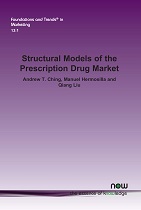Structural Models of the Prescription Drug Market
By Andrew T. Ching, Carey Business School, Johns Hopkins University, USA, andrew.ching@jhu.edu | Manuel Hermosilla, Carey Business School, Johns Hopkins University, USA, mh@jhu.edu | Qiang Liu, Krannert School of Management, Purdue University, USA, liu6@purdue.edu
Abstract
We survey the literature on structural models for the prescription drug market, which has attracted significant attention from researchers in marketing and economics, and related fields. The literature has evolved from adopting standard structural models developed for other markets to models that are specifically designed to capture the institutional details of the prescription drug market. Along the way, these empirical frameworks have not only greatly improved in terms of explaining stylized facts, but also in terms of producing better counterfactual predictions. Topics covered by this survey include the application of learning models to explain slow diffusion, post-patent expiry competition, pre-patent expiry competition, R&D and new drug introduction, managerial and public policy analysis, and the economics of the Medicare Part-D program. We conclude by discussing future research directions.
Structural Models of the Prescription Drug Market
Structural Models of the Prescription Drug Market provides a critical review of the structural econometric research focusing on the richness and complexity of the prescription drug market and discussing future research directions. Because a large number of papers rely on a Bayesian learning framework, Section 2 sets the stage by introducing the basic learning model that will be useful in later sections. Section 3 discusses the literature that makes use of individual level data. Section 4 discusses the literature that studies the product lifecycle, which primarily uses product level data. This is a broad set of articles, which includes studies focusing on persuasive versus informative effects, clinical outcomes, and publicity, as well as models r elated to pre-market behavior (such as R&D decisions and clinical trial outcomes). Section 5 addresses other related applications of structural models in this area, and Section 6 summarizes the key takeaways and discusses future research directions.
